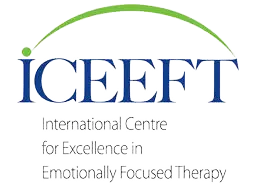Every relationship holds the potential for profound connection—yet even the strongest partnerships experience moments when communication feels challenging. If you’ve ever felt the distance that grows when words fail or misunderstandings accumulate, you’re experiencing a universal aspect of intimate relationships. Research from relationship expert Dr. John Gottman reveals that communication difficulties represent the primary concern for most couples seeking support.
Here’s what’s encouraging: effective communication isn’t an inherent talent but a learnable skill that grows through intentional practice. The ten evidence-based practices in this guide are designed to help you and your partner develop deeper understanding, reduce unnecessary conflict, and nurture the secure attachment that allows your relationship to flourish.
Why Communication Practices Matter
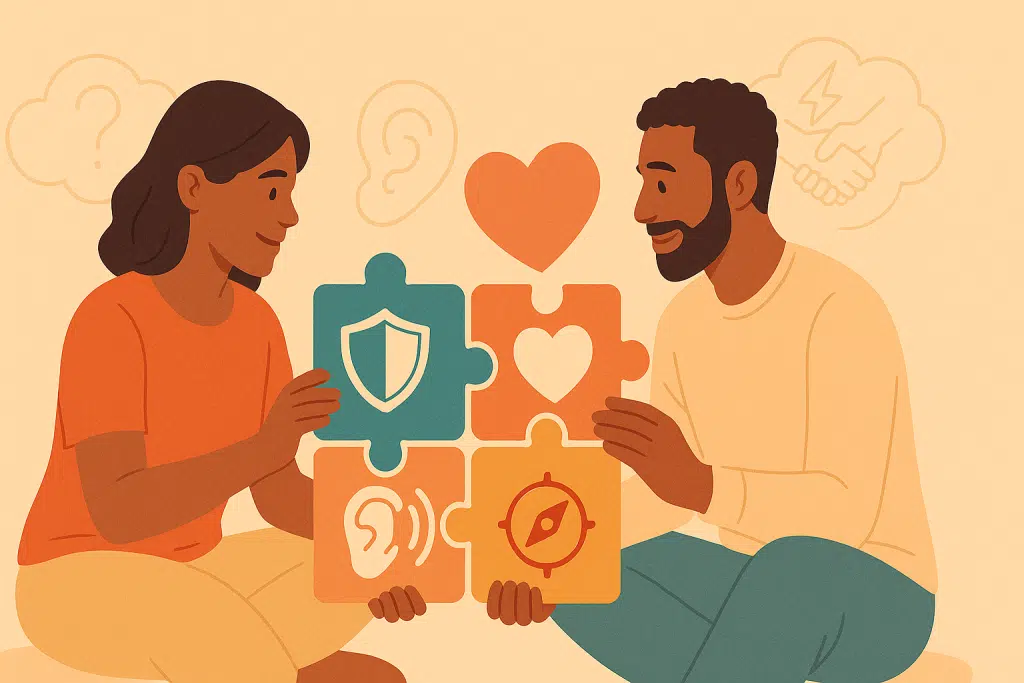
Much like other meaningful skills in life, effective communication develops through deliberate practice rather than simply occurring naturally. Just as we wouldn’t expect to excel at playing an instrument without regular practice, we can’t expect our relationship communication to thrive without dedicated attention.
The Transformative Power of Structured Communication
When couples engage in thoughtful, structured communication practices:
- They create emotional safety that invites authentic self-expression
- Misunderstandings diminish as clarity and active listening increase
- Both partners develop skills to navigate emotions during challenging conversations
- Emotional intimacy deepens through heightened vulnerability and empathy
Recognizing When Your Relationship Needs Communication Support
Every relationship experiences challenges. These common patterns often signal opportunities for communication growth:
| Pattern | How It Manifests |
| Frequent misunderstandings | Conversations that unexpectedly escalate into conflict |
| Avoiding meaningful topics | Hesitancy to discuss important matters like finances, intimacy, or parenting |
| Emotional withdrawal | One or both partners shutting down or disconnecting during difficult conversations |
| Recurring conflicts | Having the same unresolved arguments repeatedly |
If these patterns feel familiar, take heart—they simply indicate that, like most couples, you have opportunities to develop new communication skills together. The practices that follow provide practical pathways to transform these patterns.
“Communication creates the foundation upon which all other aspects of relationship flourish or falter. When couples learn to communicate with both honesty and compassion, even the most challenging issues become opportunities for deeper connection.”
Active Listening: The Art of Being Fully Present
At the heart of all meaningful communication lies the practice of active listening—fully receiving your partner’s words and feelings without formulating your response or filtering through judgment. This foundational skill transforms conversations from parallel monologues into genuine dialogue where both partners feel truly heard.
Creating Space for Authentic Listening
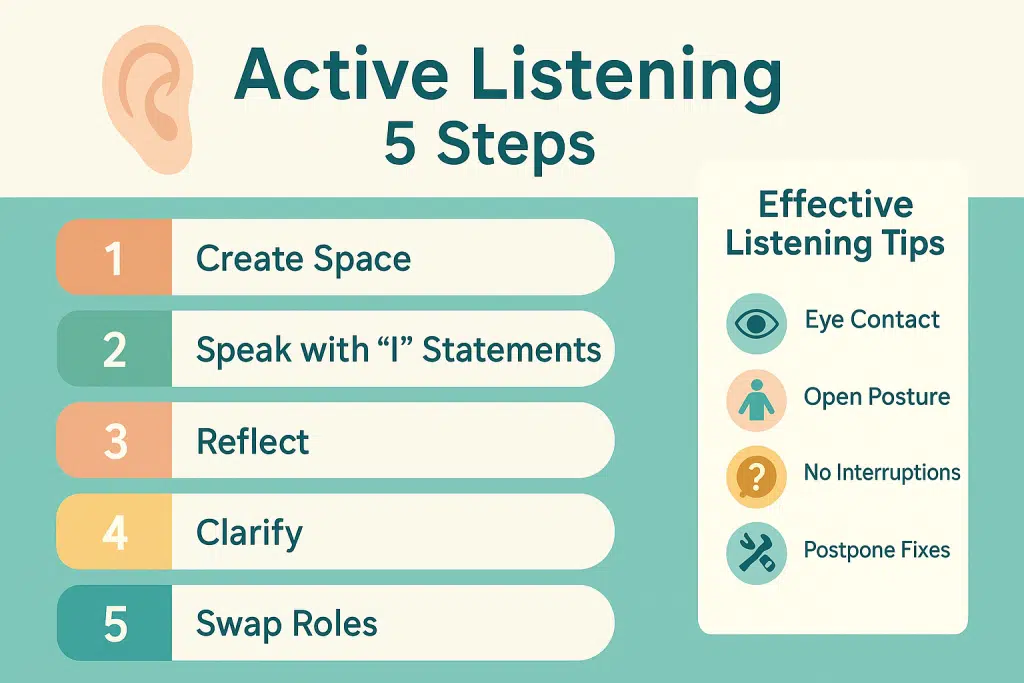
Step 1: Create a Receptive Environment
- Choose a quiet, comfortable space free from distractions
- Turn off electronic devices to signal your full presence
- Agree to speak one at a time, honouring each other’s expression
Step 2: The Speaker’s Role in Clarity As the speaker, share your experience using “I” statements that express your feelings and perceptions without blame. Keep your sharing focused and specific rather than generalized. For example:
- “I felt disappointed when our plans changed last minute.”
- “I’m feeling overwhelmed with my current responsibilities.”
Step 3: The Listener’s Sacred Task After your partner finishes speaking, reflect back what you heard to confirm understanding:
- “What I’m hearing is that you felt disappointed when our plans changed. You had been looking forward to our time together.”
- “I hear that you’re feeling overwhelmed by your responsibilities right now.”
Step 4: Clarification and Confirmation The speaker then confirms accuracy or gently clarifies:
- “Yes, that’s exactly it. Thank you for understanding.”
- “That’s close. What I meant was…”
Step 5: Exchange Roles After completion, switch positions so both partners have the opportunity to be heard and to listen.
Practical Guidance for Effective Listening
- Maintain gentle eye contact that communicates attentiveness without intensity
- Notice your body language – an open posture signals receptivity
- Resist the urge to interrupt – even when you disagree or have important points to add
- Postpone problem-solving until your partner feels completely understood
Practice Suggestion: Begin with lighter topics where emotional stakes are lower. As your listening skills develop, you can gradually approach more complex or sensitive subjects with the same attentive presence.
Research consistently shows that partners who practice active listening report greater relationship satisfaction and experience fewer escalated conflicts—a compelling reason to develop this foundational skill together.
The Daily Connection Practice
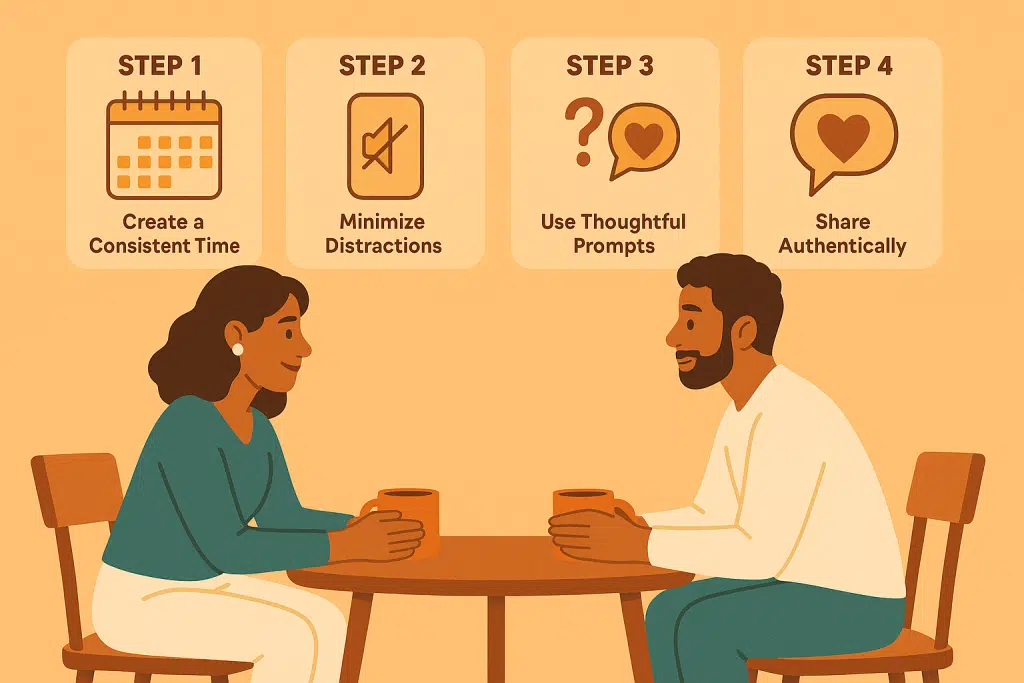
One of the most powerful yet simple communication practices is the daily check-in—a dedicated time to attune to each other’s emotional worlds. Unlike casual conversation, this intentional practice creates space for meaningful connection amidst busy lives, preventing emotional distance from developing unnoticed.
The Significance of Daily Connection
Regular, meaningful check-ins:
- Create a reliable foundation of emotional security
- Help partners remain current with each other’s inner experiences
- Prevent small concerns from growing into larger issues
- Foster continued curiosity and interest in each other’s lives
Establishing Your Daily Connection Practice
Step 1: Create a Consistent Time Set aside 10-15 minutes daily when you’re both relatively relaxed and present. This might be:
- During morning coffee before the day begins
- After work as a transition ritual
- Before bed as a gentle closing to the day
The specific time matters less than the consistency of your practice.
Step 2: Minimize Distractions Create a technology-free zone that honours the sacredness of your connection. Put phones away, turn off screens, and give each other your undivided attention.
Step 3: Use Thoughtful Prompts To move beyond surface conversation, consider questions that invite meaningful sharing:
- “What brought you joy or satisfaction today?”
- “Was there a moment today when you felt challenged or disconnected?”
- “What’s something you’re looking forward to tomorrow?”
- “Is there anything you need from me that you haven’t expressed?”
Step 4: Share Authentically The value of this practice emerges from honest expression. Rather than saying “fine” when you’re struggling, name your true feelings with the trust that your partner can hold your authentic experience.
Example of a Meaningful Check-in:
| Partner | Question | Response Example |
| Partner A | “What was meaningful about your day?” | “The conversation with my colleague about our project felt rewarding—I felt valued for my contribution.” |
| Partner B | “What challenged you today?” | “The deadline pressure at work activated my anxiety. I’m still feeling some tension in my shoulders.” |
Nurturing Your Connection Practice
- Maintain the commitment even on difficult days—often these are when connection matters most
- Keep it balanced so both partners have equal opportunity to share and be heard
- Express appreciation for your partner’s willingness to remain emotionally connected
Connection Insight: The most profound relationship transformations often come not from grand gestures but from these small, consistent moments of genuine connection repeated over time.
The Gottman Institute’s research confirms that couples who maintain consistent rituals of connection show greater resilience during challenging times and report higher relationship satisfaction overall.
Expressing Feelings with Clarity and Care: The “I Feel” Practice

When difficult emotions arise, how we express them profoundly impacts whether our partner responds with defensive distance or empathic understanding. “I Feel” statements create a bridge of connection even during challenging conversations by focusing on your experience rather than perceived flaws in your partner.
Why “I Feel” Statements Transform Communication
This practice:
- Helps you own your emotional experiences rather than projecting them outward
- Significantly reduces defensiveness by avoiding blame or criticism
- Creates clarity about your internal experience that invites understanding
- Builds emotional literacy and self-awareness for both partners
Crafting Effective “I Feel” Statements
Step 1: Name Your Authentic Feeling Identify the specific emotion underneath your reaction—moving beyond general terms like “bad” or “upset” to more precise feelings such as “disappointed,” “worried,” “overwhelmed,” or “unappreciated.”
Step 2: Describe the Situation Objectively Without interpretation or judgment, simply describe what happened. Focus on observable facts rather than assumptions about intentions.
Step 3: Express the Impact on You Share how the situation affects you emotionally, practically, or in your sense of connection.
Step 4: Make a Clear, Positive Request Rather than demanding change, invite your partner into a solution that addresses your need.
The Complete Formula: “I feel [emotion] when [objective situation] because [impact on me]. Would you be willing to [specific request]?”
Examples of Transformed Communication
| Common Expression | Transformed “I Feel” Statement |
| “You never help around the house!” | “I feel overwhelmed and unappreciated when household responsibilities aren’t shared. I’d value creating a more balanced approach to caring for our home.” |
| “You’re always on your phone when I’m talking to you.” | “I feel disconnected when there are distractions during our conversations. I’d love to have your full presence when we’re sharing important thoughts.” |
Guidance for Authentic Expression
- Use specific emotion words that accurately capture your experience
- Avoid disguised blame that begins with “I feel that you…” or “I feel like you…”
- Stay current by addressing present situations rather than accumulating past grievances
- Practice self-regulation so you can express difficult feelings from a centred rather than reactive state
Connection Insight: While “I Feel” statements may initially feel formulaic, with practice they become a natural way to express yourself authentically while preserving connection.
Research from relationship psychology shows that couples who regularly use this communication approach experience lower conflict escalation and greater emotional intimacy—creating space for genuine understanding even during challenging conversations.
The Silent Language: Developing Non-Verbal Awareness

Though words matter deeply, research indicates that up to 93% of emotional communication happens non-verbally through facial expressions, body language, tone of voice, and physical proximity. Developing conscious awareness of these unspoken messages transforms your ability to understand and be understood by your partner.
The Significance of Non-Verbal Communication
Non-verbal awareness:
- Provides direct access to emotional undercurrents in your relationship
- Helps identify disconnections before they escalate into conflict
- Creates congruence between your intentions and how they’re received
- Deepens emotional attunement between partners
Developing Non-Verbal Awareness Together
Step 1: The Mirroring Practice This simple yet profound exercise builds attunement to non-verbal signals:
- Sit facing each other in a comfortable position
- Partner A begins making subtle facial expressions and gentle movements
- Partner B mirrors these expressions and movements as precisely as possible
- After 2-3 minutes, switch roles so each partner experiences both leading and mirroring
Step 2: The Non-Verbal Check-In Once daily, take a moment to observe your partner’s non-verbal cues:
- Notice their facial expression, body posture, and energy level
- Without making assumptions, gently inquire about what you observe:
- “I notice your shoulders seem tense. How are you feeling?”
- “Your expression changed when we mentioned the family gathering. What’s coming up for you?”
Step 3: Developing Personal Awareness Begin to notice your own non-verbal signals:
- What happens in your body when you feel stressed or disconnected?
- How do your non-verbal cues shift when you feel safe and connected?
- Are there incongruencies between your words and your body language?
Understanding Common Non-Verbal Cues
| Non-Verbal Signal | Potential Meaning | Compassionate Response |
| Crossed arms, turned away | Self-protection, emotional withdrawal | Create safety; slow the conversation; check in gently |
| Limited eye contact | Discomfort, shame, or feeling overwhelmed | Reduce intensity; offer reassurance; provide space |
| Open posture, soft facial expression | Receptivity, emotional availability | Respond with similar openness; deepen the conversation |
| Tense voice or sharp tone | Stress response, feeling threatened | De-escalate by speaking softly; acknowledge the tension |
Guidance for Non-Verbal Harmony
- Align your body language with your words to create congruent communication
- Notice without judging when you observe shifts in your partner’s non-verbal signals
- Adapt your approach when you sense your partner becoming physically tense or withdrawn
- Use touch mindfully as appropriate to maintain connection during difficult conversations
Connection Insight: Non-verbal awareness creates a deeper layer of understanding that complements verbal communication, allowing subtle emotional nuances to be recognized and honoured.
Research consistently shows that couples who accurately read and respond to each other’s non-verbal cues experience greater emotional intimacy and fewer misunderstandings—highlighting the importance of this often overlooked dimension of communication.
The Practice of Appreciation and Gratitude

In the midst of life’s demands, it’s surprisingly easy to focus on what’s challenging in our relationships while taking positive qualities for granted. The consistent practice of expressing specific appreciation creates a relationship environment where both partners feel valued, seen, and cherished for their contributions.
The Transformative Power of Expressed Gratitude
Regular appreciation:
- Shifts attention toward the positive aspects of your relationship
- Creates emotional safety that supports vulnerability
- Builds resilience during challenging periods
- Reinforces behaviors that nurture the relationship
Cultivating a Practice of Appreciation
Step 1: Daily Expression of Gratitude Each day, share at least one specific quality, action, or attribute you genuinely appreciate about your partner:
- “I appreciate how attentively you listened when I shared my concerns about work.”
- “Thank you for making coffee this morning—that small gesture of care meant a lot to me.”
- “I value your thoughtfulness in remembering to call my mother on her birthday.”
Step 2: Written Expressions of Appreciation Once weekly, take a moment to write a brief note of gratitude to your partner, highlighting something specific from the week that touched you or made a difference in your life.
Step 3: The Gratitude Collection Create a shared container (a beautiful box, jar, or digital folder) where you collect expressions of appreciation. During challenging times, revisit these notes together as a reminder of your connection.
Examples of Meaningful Appreciation:
| Situation | Effective Appreciation |
| Partner prepares a meal | “I appreciate the care you put into making dinner tonight. I felt nurtured by your effort to create something we’d both enjoy.” |
| Partner shows emotional support | “Thank you for your patience when I was processing my feelings earlier. Your presence without trying to fix things helped me feel safe.” |
| Partner handles a challenging situation | “I admire how you navigated that difficult conversation with such thoughtfulness and clarity. Your emotional intelligence is something I deeply value.” |
Guidance for Authentic Appreciation
- Be specific rather than general—detail exactly what you appreciate and why it matters
- Focus on character qualities as well as actions—acknowledge who your partner is, not just what they do
- Express appreciation even during conflict—finding something to genuinely value even in challenging moments creates emotional safety
- Notice the small things—often the most meaningful appreciation acknowledges the everyday gestures that could easily be overlooked
Connection Insight: While grand romantic gestures have their place, relationships thrive on the consistent expression of genuine appreciation for the small moments that make up your shared life.
Research from positive psychology demonstrates that couples who maintain high ratios of appreciation to criticism (ideally 5:1 or higher) experience significantly greater relationship satisfaction and longevity—making this perhaps the simplest yet most powerful practice you can implement.
The Mirroring Practice: Creating True Understanding
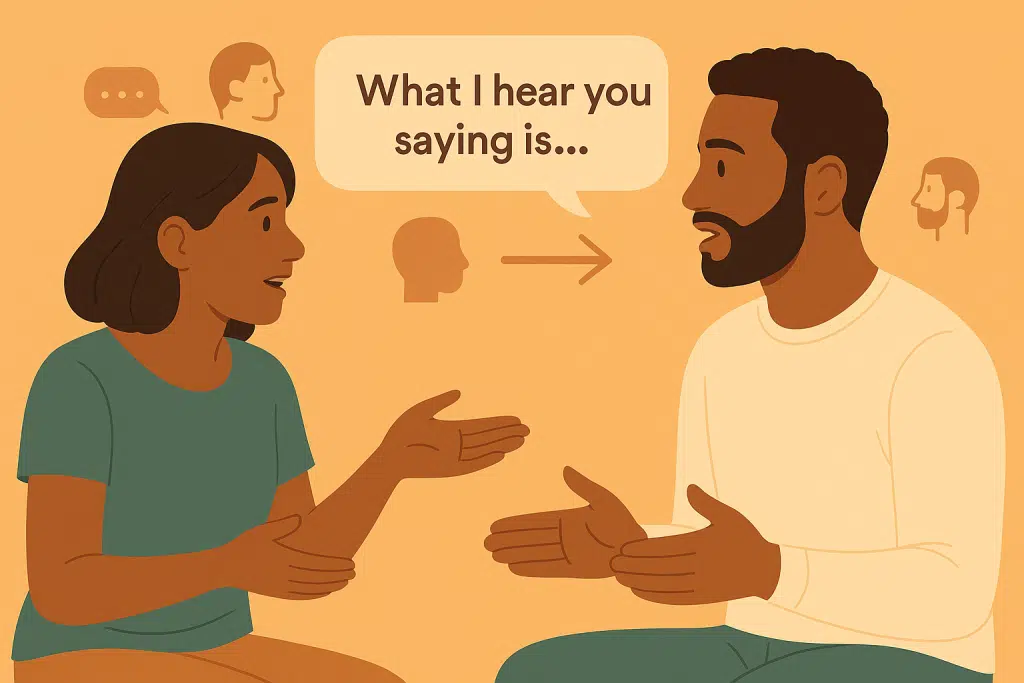
When conversations become heated or complex, partners often speak past each other, responding to what they think was said rather than what was actually expressed. The Mirroring Practice creates a structured way to slow down communication and verify understanding before moving forward—dramatically reducing misunderstandings and reactive responses.
Why Mirroring Creates Breakthrough Understanding
This practice:
- Ensures accurate understanding before responding
- Slows down reactive communication patterns
- Creates the profound experience of feeling genuinely heard
- Builds the neural pathways for more effective listening
The Mirroring Process
Step 1: Speaker Shares Briefly The speaker expresses a single thought, feeling, or concern briefly (30-60 seconds), using “I” statements and speaking from personal experience.
Step 2: Listener Mirrors With Accuracy The listener reflects back what they heard, staying as close as possible to the speaker’s actual words:
- “What I’m hearing you say is…” (followed by paraphrasing)
- “If I understand correctly, you’re feeling…” (followed by reflection)
Step 3: Speaker Validates or Clarifies The speaker confirms accuracy or gently redirects:
- “Yes, you understood me completely.”
- “That’s partly right. What I was trying to express was…”
Step 4: Continue the Process Continue with the speaker sharing the next piece, followed by mirroring, until the complete message has been expressed and accurately received.
Step 5: Exchange Roles After the first partner’s complete expression has been thoroughly understood, partners switch roles.
Example Mirroring Dialogue:
| Speaker | Listener’s Mirror | Speaker’s Response |
| “I feel anxious when we don’t discuss financial decisions together. It triggers my fears about security.” | “What I hear you saying is that you feel anxious when financial decisions are made without discussion because it affects your sense of security. Did I understand that correctly?” | “Yes, exactly. I’m not questioning your judgment—I just need to feel included in the process.” |
Guidance for Effective Mirroring
- Resist adding interpretation to what your partner has shared
- Maintain a curious, open stance rather than preparing your defence
- Mirror tone and emotion as well as content when appropriate
- Start with lower-intensity topics while learning the practice
Connection Insight: Though mirroring may initially feel mechanical, with practice it becomes a natural way to ensure understanding before responding—creating space for thoughtful dialogue rather than reactive exchanges.
This practice, developed and refined by relationship experts including Harville Hendrix and Helen LaKelly Hunt in Imago Relationship Therapy, has transformed communication patterns for countless couples, allowing them to move from disconnection to profound understanding.
Constructive Conflict: Transforming Differences into Connection

Conflict itself isn’t harmful to relationships—it’s how conflict unfolds that determines whether it damages connection or becomes an opportunity for growth and deeper understanding. This practice helps you transform potential arguments into productive conversations that actually strengthen your bond.
The Purpose of Constructive Conflict
Approaching differences constructively:
- Honours both partners’ perspectives and needs
- Prevents resentment from accumulated unresolved issues
- Develops crucial skills for navigating life challenges together
- Transforms potential disconnection into opportunities for growth
Practicing Constructive Conflict Through Role-Play
Step 1: Create Sacred Space Choose a calm time to practice when you’re not actually in conflict:
- Find a comfortable, private setting
- Agree on a realistic but manageable topic to discuss
- Set a specific timeframe (15-20 minutes)
Step 2: Establish Supportive Guidelines Agree to approach the practice with:
- Gentle tone and regulated emotions
- Full presence and active listening
- Curiosity rather than defensive postures
Step 3: Engage in the Conversation One partner begins by expressing their perspective on the chosen topic:
- Use “I feel” statements to express emotions
- Clearly articulate needs without demands
- Avoid criticism or contempt
The other partner practices active listening and mirroring responses.
Step 4: Exchange Perspectives After fully exploring one viewpoint, switch roles so the other partner can share their perspective while receiving the same attentive listening.
Step 5: Find Points of Connection Together, identify:
- Areas of agreement and shared values
- Understanding of each other’s core concerns
- Possible approaches that honor both perspectives
Example Constructive Conflict Scenario:
| Topic | Partner A’s Perspective | Partner B’s Perspective | Potential Connection Points |
| Different social needs | “I feel energized by social gatherings and connection with friends.” | “I need quiet time to recharge after social events.” | Both value quality connection; both have valid needs for balance; scheduling can accommodate both needs |
After the Practice: Integration and Learning
Take time to reflect together on the experience:
- “What did we learn about each other through this conversation?”
- “Which moments felt most connected? Which felt challenging?”
- “How might we bring these skills into real conflicts?”
Guidance for Transforming Conflict
- Stay focused on one issue rather than bringing in multiple concerns
- Monitor your physiological state—if you notice signs of flooding (racing heart, shallow breathing), request a brief pause
- Look beyond positions to interests—explore what needs or values underlie each perspective
- Remember your partnership—approach the conversation as allies solving a shared problem
Connection Insight: When approached with openness and respect, differences don’t have to divide you—they can actually create a richer, more textured relationship that honors both individuals.
Research consistently shows that it’s not the presence of conflict but how couples navigate disagreement that predicts relationship satisfaction and longevity—making this practice essential for long-term relational health.
Shared Journaling: Creating a Written Dialogue

For some couples, certain thoughts and feelings feel easier to express in writing than in face-to-face conversation. Shared journaling creates a thoughtful space for reflection, allowing complex emotions to be articulated with care and received without immediate response.
The Value of Written Expression
Shared journaling:
- Creates space for thoughtful reflection before expression
- Allows complete thoughts to be shared without interruption
- Provides documentation of growth and insights over time
- Offers an alternative communication channel for processing complex feelings
Establishing Your Shared Journaling Practice
Step 1: Choose Your Format Select an approach that feels accessible to both partners:
- A beautiful physical journal that stays in a special place in your home
- A digital document or note that you can both access
- Individual entries shared through email or messaging
Step 2: Create Supportive Boundaries Agree on guidelines that create safety:
- Journal entries are received with openness rather than defensiveness
- Written expressions are treated with the same respect as spoken words
- Decide together whether and how you’ll discuss entries
Step 3: Establish a Rhythm Determine a frequency that feels sustainable:
- Weekly entries from each partner
- Alternating entries responding to each other
- Spontaneous entries when inspiration or need arises
Step 4: Use Thoughtful Prompts Consider questions that invite meaningful reflection:
- “Something I appreciate about our relationship right now is…”
- “A growth edge I’m working on in myself is…”
- “I feel most connected to you when…”
- “Something I find challenging to express verbally is…”
Examples of Meaningful Journal Entries:
| Partner | Prompt | Sample Entry |
| Partner A | “What I’m learning about myself…” | “I’m realizing how much my family’s approach to conflict impacts how I respond when we disagree. I tend to withdraw because expressing disagreement felt unsafe in my childhood home. I’m working on staying present even when it feels vulnerable.” |
| Partner B | “Something I want you to understand…” | “When I ask questions about your day, it’s not about checking up on you—it’s because I genuinely care about your experiences and want to feel connected to your world, even the ordinary moments.” |
Guidance for Meaningful Journaling
- Write from the heart with authenticity rather than performance
- Use “I” language that expresses your experience without blame
- Respond with appreciation for your partner’s vulnerability
- Notice patterns over time that might reveal deeper themes
Connection Insight: The written word creates a special kind of intimacy—thoughts can be carefully crafted, and the reader can take time to fully absorb the message before responding.
This practice offers particular value for couples where one or both partners process internally before speaking, or where verbal conversations sometimes escalate quickly into misunderstanding.
Emotional Mapping: Understanding Your Inner Landscapes
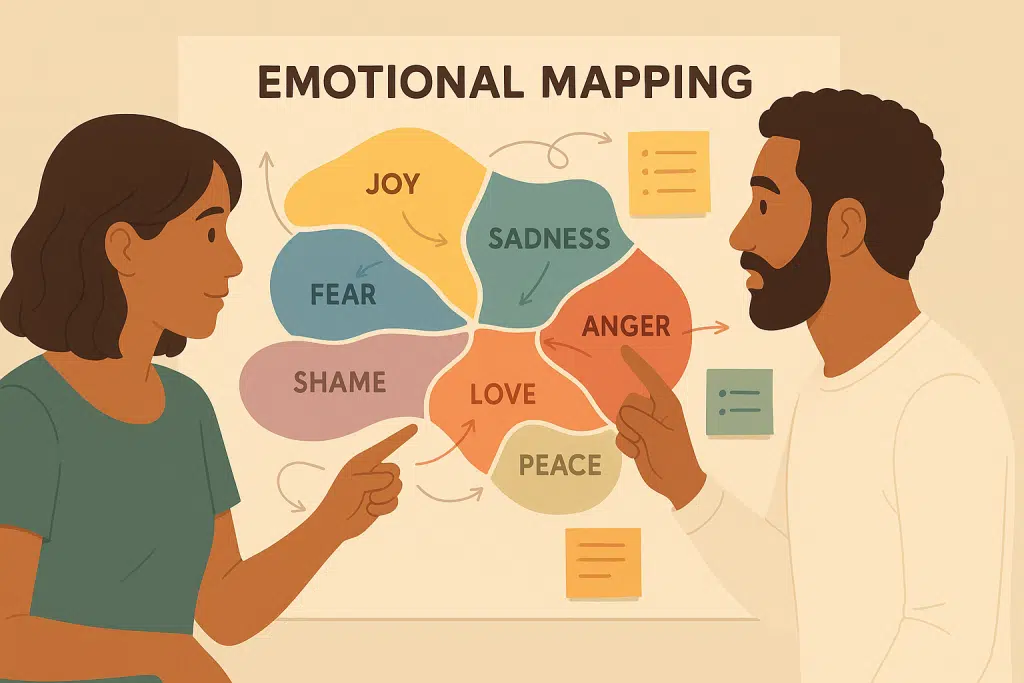
Every relationship contains two unique emotional worlds—individual patterns of triggers, responses, and needs shaped by temperament, attachment history, and life experience. Emotional mapping creates visual representation of these internal landscapes, helping couples navigate each other’s emotional terrain with greater awareness and compassion.
The Purpose of Emotional Mapping
This practice helps you:
- Identify patterns in emotional responses
- Recognize triggers before they escalate
- Develop greater empathy for your partner’s emotional experience
- Create shared language for discussing emotional states
Creating Your Emotional Maps
Step 1: Gather Materials Select tools that support creative expression:
- Large paper or poster board
- Colored markers, pencils, or pens
- Sticky notes for adding details
Step 2: Identify Core Emotions Each partner identifies their primary emotional experiences, such as:
- Joy
- Sadness
- Fear
- Anger
- Shame
- Peace
- Love
Step 3: Connect Emotions to Triggers and Responses For each emotion, identify:
- Situations that typically evoke this feeling
- Physical sensations associated with the emotion
- Typical behavioural responses
- What helps when experiencing this emotion
Example Emotional Mapping Elements:
| Emotion | Triggers | Physical Signs | Typical Response | What Helps |
| Anxiety | Financial pressure; Conflict avoidance; Time pressure | Chest tightness; Shallow breathing; Restlessness | Withdrawing; Over-planning; Seeking reassurance | Gentle reassurance; Time to process; Physical comfort |
Step 4: Share and Discuss Your Maps Take turns presenting your emotional maps to each other:
- Explain the patterns you’ve identified
- Share insights about your emotional responses
- Listen with curiosity to your partner’s map
- Ask thoughtful questions to deepen understanding
Integration and Application
After creating your maps, discuss:
- “What surprised you about my emotional patterns?”
- “How might we better support each other during emotional challenges?”
- “What similar or complementary patterns do you notice in our maps?”
Guidance for Compassionate Mapping
- Approach with curiosity rather than judgment about emotional patterns
- Remember that all emotions serve purposes—even difficult ones
- Notice connections between current triggers and past experiences
- Update your maps periodically as you grow and change
Connection Insight: Understanding the geography of each other’s emotional worlds allows you to navigate challenging terrain together with greater skill and compassion.
This practice draws on principles from emotion-focused therapy and attachment theory, helping couples develop what Dr. Sue Johnson calls “emotional intelligence in action”—the ability to recognize, understand, and respond effectively to emotional signals in the relationship.
Shared Vision: Aligning Dreams and Purpose
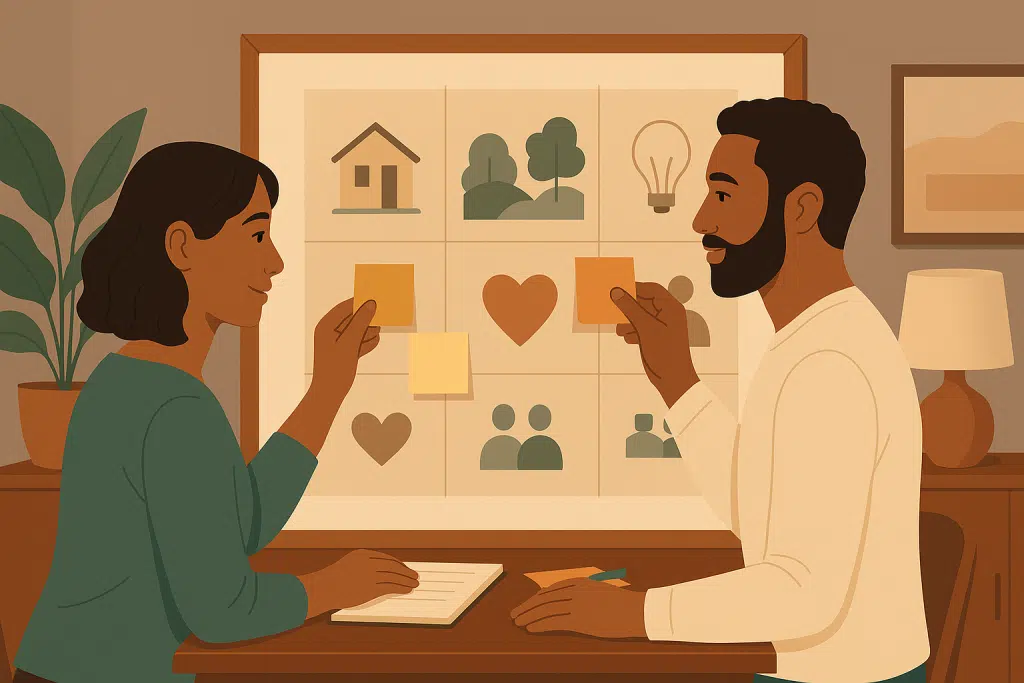
Beyond daily communication lies the deeper dimension of shared meaning—the sense that your relationship has purpose and direction that matters to both of you. This practice helps you articulate individual and collective dreams, creating a vision that guides your growth together.
The Significance of Shared Vision
Creating shared meaning:
- Provides direction and purpose beyond daily logistics
- Strengthens commitment through aligned future possibilities
- Helps navigate decisions with clearer priorities
- Creates a foundation of common values amid differences
Cultivating Your Relationship Vision
Step 1: Create a Reflective Space Choose a time when you both feel present and relaxed:
- Perhaps during a weekend morning or evening
- Away from daily distractions and pressures
- With enough time to explore deeply (at least an hour)
Step 2: Begin with Individual Reflection Separately consider questions such as:
- “What values matter most deeply to me in our relationship?”
- “What dreams do I hold for our future together?”
- “What legacy would I like our relationship to create?”
- “How do I hope we’ll grow together over the coming years?”
Step 3: Share Individual Visions Take turns expressing your reflections:
- Share with openness and vulnerability
- Listen with curiosity rather than evaluation
- Look for themes and connections between your visions
Step 4: Craft a Shared Vision Together, create a vision that honours both individual dreams and collective aspirations:
- Identify common values and dreams
- Look for complementary elements between different hopes
- Create language that resonates with both partners
Examples of Vision Elements:
| Life Area | Individual Hopes | Potential Shared Vision |
| Home | Partner A: Urban living with cultural access<br>Partner B: Space and natural surroundings | “A home that balances connection to nature with access to cultural experiences” |
| Family | Partner A: Focus on immediate family unit<br>Partner B: Strong extended family ties | “Nurturing our intimate family bonds while honoring and maintaining meaningful extended family connections” |
| Purpose | Partner A: Professional achievement<br>Partner B: Community contribution | “Supporting each other’s professional growth while finding ways to contribute meaningfully to our community” |
Step 5: Revisit and Refine Return to your shared vision periodically:
- Update as you grow and change
- Celebrate aspects you’ve manifested
- Refine elements that no longer resonate
Guidance for Vision Creation
- Dream boldly without limiting possibilities prematurely
- Hold the vision lightly enough to allow for evolution
- Look for higher-order connections beneath surface differences
- Create concrete representations of your vision (written statements, images, or symbols)
Connection Insight: A shared vision doesn’t mean identical dreams—it means creating a future together where both partners’ core values and aspirations can flourish side by side.
Research from the Gottman Institute demonstrates that couples who create shared meaning and vision show greater resilience during challenges and higher overall relationship satisfaction—making this practice a worthy investment in your relationship’s future.
Integrating These Practices Into Your Relationship
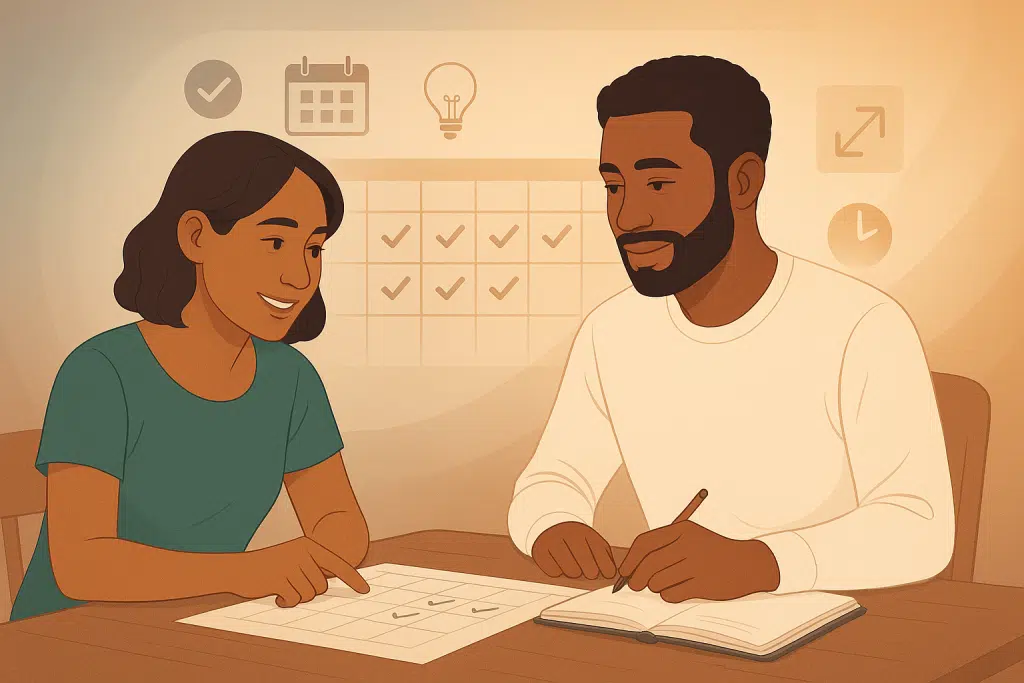
As you explore these communication practices, you might wonder how to incorporate them sustainably into your relationship. Here are thoughtful responses to common questions:
“How quickly will we notice changes in our communication patterns?”
Most couples experience immediate moments of deeper connection when implementing these practices. However, lasting transformation of communication patterns typically emerges over time as new neural pathways develop. Many couples notice significant shifts after 3-4 weeks of consistent practice, though deeper patterns may take several months to transform fully.
The key is consistency rather than perfection—even implementing one practice with regularity creates meaningful change.
“What if my partner seems hesitant to engage in these practices?”
Begin by sharing your intentions with warmth rather than pressure: “I value our relationship and am interested in exploring ways we might connect even more deeply. Would you be open to trying one of these practices together?”
Start with practices that feel most accessible to both of you—perhaps daily appreciation or the check-in ritual. As trust in the process builds, your partner may become more open to additional practices.
Remember that change often begins with one person—as you shift your communication approach, the relationship dynamic naturally evolves, often inspiring your partner to engage more fully.
“How can we maintain these practices during busy or stressful periods?”
During challenging times, simplify rather than abandon your practices:
- Shorten your daily check-in to five minutes while maintaining its essence
- Focus on brief expressions of appreciation even on the busiest days
- Remember that high-stress periods are precisely when communication practices offer the greatest benefit
Consider scheduling your most important practices in your calendar to maintain consistency during demanding seasons.
“What if these practices bring up difficult emotions or unresolved issues?”
This is actually a sign that the practices are working effectively—creating space for authentic expression of feelings that may have been beneath the surface. When challenging emotions arise:
- Acknowledge them with compassion rather than alarm
- Use the active listening and mirroring practices to understand them more deeply
- Remember that expressing difficult feelings in a supported way leads to healing
- Consider seeking professional support if you encounter patterns that feel overwhelming
“Is couples therapy recommended alongside these practices?”
These communication practices complement professional support beautifully. While many couples make significant progress independently, therapy offers unique benefits:
- Expert guidance tailored to your specific relationship patterns
- A neutral, supportive environment for exploring difficult topics
- Professional insight into attachment patterns and emotional dynamics
- Structured support for implementing and refining these practices
Consider therapy as an investment in your relationship’s growth rather than a last resort—many couples find that even a few sessions provide valuable insights and direction.
Seek Professional Help From A Certified Couples Therapist at Couples Counselling Centre
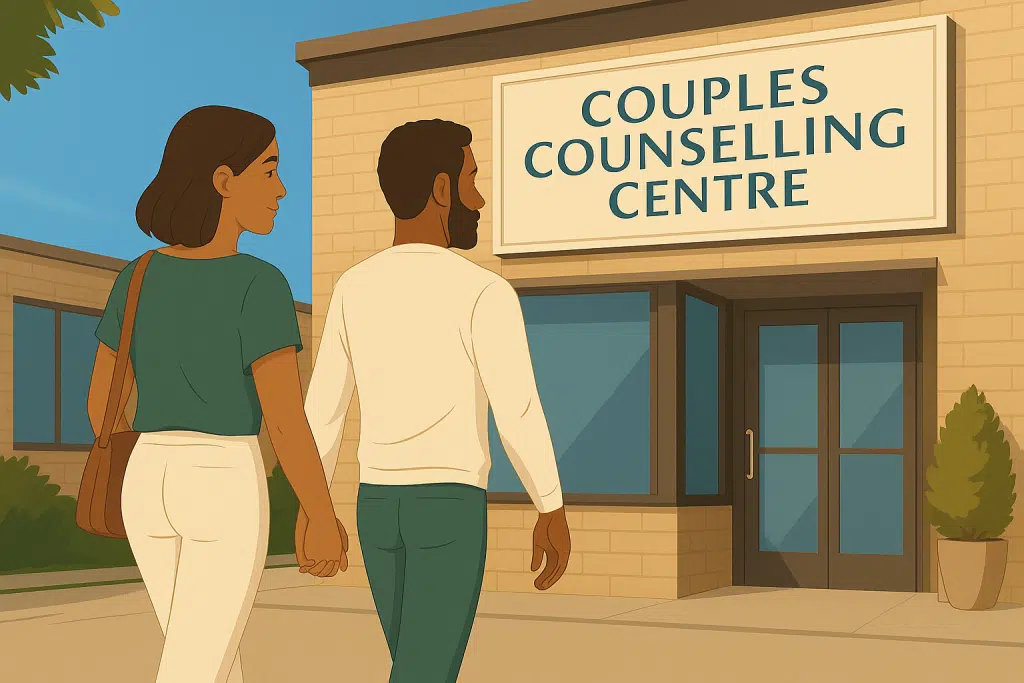
At Couples Counselling Centre, we believe that secure connection forms the foundation for lasting love. These communication practices reflect our commitment to helping couples develop the skills that nurture authentic intimacy and resilience.
If you’d like personalized support in transforming your relationship communication, we invite you to contact us or learn more about our couples therapy — we’re here to support your journey toward deeper connection.
Resources for Continued Growth
Your commitment to developing these communication practices reflects the value you place on your relationship. These additional resources can support your continued growth:
Books That Deepen Understanding
- Hold Me Tight by Dr. Sue Johnson
- The Seven Principles for Making Marriage Work by Dr. John Gottman
- Nonviolent Communication by Marshall B. Rosenberg
Podcasts for Relationship Wisdom
- Where Should We Begin? with Esther Perel
- Small Things Often from The Gottman Institute
- Foreplay Radio with Dr. Laurie Watson
Relationship Education Programs
- Emotionally Focused Therapy (EFT) Workshops
- Gottman Method Couples Workshops
- Imago Relationship Workshops
Remember that communication growth isn’t about reaching perfection but about creating a continuing journey of deeper understanding and connection. Each practice you implement creates new possibilities for intimacy, understanding, and shared meaning in your relationship.





